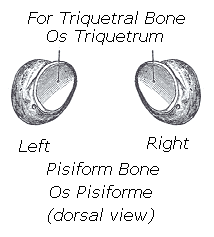User:David Hume/sandbox: Difference between revisions
imported>David Hume No edit summary |
imported>David Hume No edit summary |
||
| Line 16: | Line 16: | ||
The Triangular Bone (os triquetrum; cuneiform bone) | The Triangular Bone (os triquetrum; cuneiform bone) | ||
lentiform bone | |||
The etymology derives from the Latin pīsum which means "pea." | |||
By comparison, the term "palm" applies to only the palm (the grasping side) of the hand. The Romans actually used the word "palma" for the outstretched palm of the hand. | By comparison, the term "palm" applies to only the palm (the grasping side) of the hand. The Romans actually used the word "palma" for the outstretched palm of the hand. | ||
Revision as of 14:38, 26 February 2007
pisiform bone (os pisiforme)
parent article - wrist or carpus
The pisiform bone (os pisiforme) can be distinguished by its small size, and having a single articular facet. It is pea-shaped and is situated anteriorly to the other bones of the wrist. Its dorsal surface presents a smooth, oval facet, for articulation with the triquetral bone. This facet approaches the superior, but not the inferior border of the bone. The palmar (volar) surface is rounded and rough, giving attachment to the transverse carpal ligament, and to the flexor carpi ulnaris and abductor digiti quinti. The lateral and medial surfaces are also rough, the former being concave, the latter usually convex.
Articulation: the pisiform bone articulates only with one other bone, the triquetral.
Volar: Pertaining to both the palm and sole. It comes from word "vola" which the ancient Romans used for "the palm of the hand and the sole of the foot."
cf palmar (palm side of hand)and plantar (sole of foot)
The Triangular Bone (os triquetrum; cuneiform bone)
lentiform bone The etymology derives from the Latin pīsum which means "pea."
By comparison, the term "palm" applies to only the palm (the grasping side) of the hand. The Romans actually used the word "palma" for the outstretched palm of the hand.
Topics in Anatomy
SYSTEMIC ANATOMY Introduction and Systemic Overview
- Anatomical Nomenclature
- Basic Structure and Function of Cells
- Integrating Cells into Tissues
Systemic Overview
- Nervous System
- Blood, Lymphoid Tissues and Haemopoiesis
- Functional Anatomy of the Musculoskeletal System
- Smooth Muscle and the Cardiovascular and Lymphatic systems
- Skin and its Appendages
- Endocrine System
- Principles of Hormone Production and Secretion
- Embryology
- Embryogenesis
- Prenatal and Neonatal Growth
- full skeleton
- axial skeleton
- skull
- vertebral column
- ribcage
- appendicular skeleton
- shoulder & arm
- hand & wrist
- pelvis
- leg & ankle
- foot
- full body
- muscle histology
- head & neck
- thorax
- shoulder & upper arm
- biceps brachii
- forearm & hand
- abdomen
- pelvis
- thigh & knee
- leg & foot
- endocrine system
- hypothalamus & pituitary
- thyroid & parathyroids
- adrenal glands
- pancreas
- ovaries
- testes
